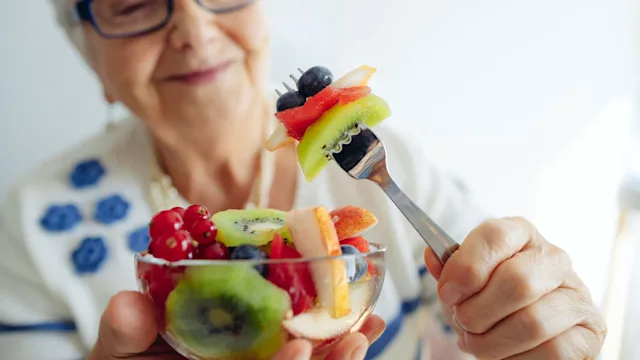Key takeaways:
Eating a high-fiber breakfast can support your gut health, blood sugar levels, and weight.
Examples of high-fiber breakfast foods are oatmeal, avocado toast, and smoothies.
You can add nuts, seeds, and fruit to your favorite breakfast foods to naturally bump up the fiber content of your meal.
Maybe you’ve heard that breakfast is the most important meal of the day. That statement may or may not be true for all people. But it’s true that what you choose to eat for breakfast can impact your overall health. Eating a high-fiber breakfast has many benefits, including blood sugar management, improved heart health, and support for weight management.
Here are 11 examples of high-fiber breakfast foods that you can add to your morning rotation. We’ll also take a look at what science says about how high-fiber foods — and breakfast, in particular — can benefit your health.
1. Oatmeal
Oatmeal is an excellent high-fiber breakfast. Half a cup of rolled oats makes about a cup of cooked oatmeal and contains 5 g of fiber. That’s nearly 20% of the daily value (DV). If you mix in other high-fiber toppings — like nuts, chia or flaxseeds, nut butter, or sliced fruit — you’ll increase the amount of fiber even more.
Keep in mind that instant oatmeal often contains added sugar and less fiber. So, you’re better off using rolled oats or steel-cut oats.
2. Avocado toast
Avocado toast is trendy — and it’s also nutrient-rich. Half a medium-sized avocado has nearly 7 g of fiber. If you use whole-grain toast, instead of toast made from white flour, you’ll get another 2 g of fiber.
Drizzle extra-virgin olive oil on the avocado to enhance its flavor and add more heart-healthy fat. A scoop of cottage cheese adds calcium and belly-filling protein.
3. Smoothie
There are endless ways to create a smoothie. But as long as you include a couple types of fruit or veggies (or both), your drink will be a good source of fiber.
For example, a smoothie that uses half a banana and a ½ cup of strawberries provides 3 g of fiber. Adding mix-ins, like 1 tbsp of almond butter and 2 tbsp of ground flaxseeds, adds about another 5 g.
4. Berries
Berries are among the fruits that are highest in fiber. Raspberries and blackberries have 8 g of fiber per cup. Strawberries and blueberries have about half that amount (3 g to 4 g per cup). Sprinkle berries onto cold cereal, oatmeal, or yogurt.
Does fiber help with weight loss? Yes, fiber increases fullness, curbs your appetite, and stabilizes blood sugar levels — all of which help with weight loss and keeping weight off.
Soluble vs. insoluble fiber: Each type of fiber provides different health benefits. And most high-fiber foods contain a bit of both soluble and insoluble fiber.
High-fiber foods to add to your diet: Find some of the most fiber-rich whole grains, fruits and vegetables, nuts and seeds, and beans in this list of high-fiber foods.
5. Whole-grain pancakes
Regular pancakes contain little to no fiber since they’re made with white flour. But it’s easy to swap out refined flour for a whole grain flour. All whole-grain flours — whether wheat, oat, corn, barley, or rice — contain fiber. Topping your pancakes with nut butter or fruit adds even more fiber.
6. Chia seed pudding
Chia seeds are packed with fiber, protein, omega-3 fatty acids, and antioxidants. These seeds turn into a gel when mixed with liquids, so it’s best to add them to moist foods, like yogurt or smoothies.
Another popular way to eat chia seeds for breakfast is in chia pudding, which you can prepare the night before.
Here’s how to make your own chia pudding:
Combine chia seeds and milk. Add your milk of your choice to chia seeds. Try a 1 to 4 ratio of chia seeds to liquid. (You can experiment to find your preferred texture.) Using 2 tbsp of chia seeds will give you 8 g of fiber along with 4 g of protein — another nutrient that helps you feel full.
Sweeten. Add a small amount of honey or other natural sweetener.
Mix. Stir and refrigerate overnight.
Top. Add your favorite toppings.
Quiz: What should I eat for breakfast?
7. Breakfast burrito with beans
Beans are another plant food that’s high in both fiber and protein. Half a cup of cooked black beans provides 7.5 g of fiber. Try a breakfast burrito using:
A whole-grain tortilla
Scrambled eggs
Diced veggies
Beans
8. Yogurt parfait
Yogurt contains important nutrients, like calcium, fat, and protein. But it doesn’t contain fiber. So, add high-fiber toppings, like:
Granola
Fruit
Flax, chia, or pumpkin seeds
Nuts or nut butter
For a yogurt parfait with the lowest amount of sugar and the highest amount of protein, stick to plain Greek yogurt.
9. Acai bowl
Acai is a type of berry that’s popular to freeze, blend with a milk or another liquid, and eat in bowl form. The taste and texture are similar to a thick smoothie. Acai berries (and their puree) contain fiber on their own. But you can also top an acai bowl with high-fiber add-ons, like granola or coconut flakes.
10. Whole-wheat English muffin
One whole-wheat English muffin has about 3 g of fiber. Topping it with 2 tbsp of peanut butter and a sliced banana makes a breakfast with 8 g of fiber.
11. Some breakfast cereals
Many breakfast cereals aren’t very good for you. But it’s possible to find a healthy cereal. Cereals made with whole grains will contain fiber. A good rule of thumb is to try to choose a cereal with 3 g of fiber or more per serving. Top your cereal with sliced banana, raisins, or berries to add more fiber.
What are the benefits of a high-fiber breakfast?
Here are some of the health benefits of eating high-fiber breakfasts.
Blood sugar management
Blood sugar control is a marker of good health for everyone, regardless of whether or not you have diabetes. Eating high-fiber breakfast foods helps stabilize your blood sugar response (how fast your blood sugar rises after eating), from the very start of your day. This can help reduce cravings throughout the day. It also helps your body properly respond to the hormone insulin.
Improved digestion and bowel movements
Fiber plays many roles in digestive health, including:
Helping to move food efficiently through your digestive tract — and out as soft, easy-to-pass stool
Serving as food for the beneficial probiotic bacteria living in your gut
Preventing constipation, diarrhea, and other digestive symptoms, like bloating, cramping, and gas
Support for weight loss and weight management
Foods that are high in fiber promote satiety, a feeling of fullness after eating. This is especially true when fiber is combined with protein, since protein also fills you up. Feeling full helps you eat less overall, which may support weight loss or weight maintenance.
One study divided participants into two groups: those who ate a low-fiber breakfast and those who ate a high-fiber breakfast. Those in the high-fiber breakfast group had more improvements in body weight after 12 weeks.
Better heart health
Fiber supports a healthy heart in many ways. A diet that’s high in fiber is linked to:
A lower risk of heart disease and stroke
Lower “bad” LDL (low-density lipoprotein) cholesterol
Lower blood pressure, especially in people with hypertension
A look at several studies over decades of research on heart health and fiber suggests that people who ate more fiber were less likely to get sick — or die — from cardiovascular disease.
And research suggests that having fiber at breakfast, specifically, may be especially helpful. One study found that people who reported eating breakfast daily were less likely to die from heart disease or any cause (compared to those who skipped breakfast). But people who ate high-fiber breakfasts were even less likely to die from heart disease or any other cause during the study.
How much fiber should you eat at breakfast?
Try to aim for 7 g to 10 g of fiber at breakfast. This amount will fill you up and help you reach the FDA’s recommended goal of 28 g per day.
But be sure to increase your fiber intake gradually. And drink plenty of water while eating high-fiber foods, since fiber requires water in order to work properly. It’s best to spread out your fiber intake throughout the day.
Frequently asked questions
Scrambled eggs don’t contain fiber. But they can be part of a high-fiber breakfast if you add diced veggies or beans. Or you can have eggs alongside a high-fiber food, such as oatmeal, whole-grain toast, or fruit.
Peanut butter is high in fiber. But you probably eat peanut butter in small quantities. So, although it won’t make up a large portion of your daily fiber intake, peanut butter can contribute to it. A 2 tbsp serving of peanut butter has about 2 g of fiber. Try peanut butter as a dip for fruit or as a high-fiber add-in for a smoothie.
Which breakfast has the most fiber depends on how you prepare the meal. For example, eggs don’t contain fiber. But scrambled eggs with beans and a side of berries is a high-fiber breakfast. If you learn which foods are high in fiber, you can build meals around the high-fiber foods you like.
Scrambled eggs don’t contain fiber. But they can be part of a high-fiber breakfast if you add diced veggies or beans. Or you can have eggs alongside a high-fiber food, such as oatmeal, whole-grain toast, or fruit.
Peanut butter is high in fiber. But you probably eat peanut butter in small quantities. So, although it won’t make up a large portion of your daily fiber intake, peanut butter can contribute to it. A 2 tbsp serving of peanut butter has about 2 g of fiber. Try peanut butter as a dip for fruit or as a high-fiber add-in for a smoothie.
Which breakfast has the most fiber depends on how you prepare the meal. For example, eggs don’t contain fiber. But scrambled eggs with beans and a side of berries is a high-fiber breakfast. If you learn which foods are high in fiber, you can build meals around the high-fiber foods you like.
The bottom line
Starting your day with a high-fiber breakfast is good for your health in many ways. It may help reduce cravings throughout the day. And it makes it more likely that you’ll get enough daily fiber. This is important because a diet that’s high in fiber is linked to better blood sugar control, weight management, and a healthier heart. There are many high-fiber breakfast foods to choose from, including oatmeal, smoothies, and whole-grain avocado toast.

Why trust our experts?



References
Anderson, J. W., et al. (2009). Health benefits of dietary fiber. Nutrition Reviews.
Hu, X., et al. (2013). Soy fiber improves weight loss and lipid profile in overweight and obese adults: A randomized controlled trial. Molecular Nutrition Food Research.
King, D. E., et al. (2021). A relationship between mortality and eating breakfast and fiber. Journal of the American Board of Family Medicine.
Maki, K. C., et al. (2023). The effects of breakfast consumption and composition on metabolic wellness with a focus on carbohydrate metabolism. Advances in Nutrition.
McRae, M. P. (2017). Dietary fiber is beneficial for the prevention of cardiovascular disease: An umbrella review of meta-analyses. Journal of Chiropractic Medicine.
MyFoodData. (n.d.). Almond butter.
MyFoodData. (n.d.). Avocados.
MyFoodData. (n.d.). Bananas.
MyFoodData. (n.d.). Blue Chip Group Inc. - rolled oats.
MyFoodData. (n.d.). Cooked black beans.
MyFoodData. (n.d.). Muffin English whole wheat.
MyFoodData. (n.d.). Peanut butter (smooth).
MyFoodData. (n.d.). Strawberries.
MyFoodData. (n.d.). Target Stores - ground flaxseed meal.
MyFoodData. (n.d.). Toasted whole wheat bread.
NutritionValue.org. (n.d.). Pure acai antioxidant superfood puree by Acai Roots.
Rania, M., et al. (2023). Reactive hypoglycemia in binge eating disorder, food addiction, and the comorbid phenotype: Unravelling the metabolic drive to disordered eating behaviours. Journal of Eating Disorders.
U.S. Food and Drug Administration. (2024). How to understand and use the nutrition facts label.
Whelton, S. P., et al. (2005). Effect of dietary fiber intake on blood pressure: A meta-analysis of randomized, controlled clinical trials. Database of Abstracts of Reviews of Effects (DARE): Quality-assessed Reviews.














